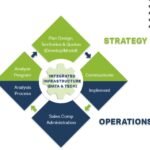In today’s competitive business landscape, attracting and retaining top talent is more important than ever. Companies are quickly realizing that the secret to long-term success isn’t just about profits and products—it’s about people. An employee-centered workplace not only fosters greater engagement but also drives productivity and innovation. So, how can you create such an environment? Here’s a step-by-step guide to building a workplace where employees thrive.
1. Foster Open Communication
Effective communication is at the heart of any successful workplace. An open-door policy encourages employees to share their thoughts, concerns, and ideas without fear of judgment or retribution. Regular one-on-one meetings between managers and employees can help facilitate honest discussions, providing employees with a platform to express their needs and aspirations.
Encouraging transparency in decision-making processes also helps employees feel more involved and invested in the company’s goals. Whether it’s through town hall meetings or team huddles, ensuring everyone has a voice leads to a more engaged and motivated workforce.
2. Promote Work-Life Balance
Burnout is a significant issue in many workplaces today, and companies that prioritize work-life balance are more likely to have satisfied and productive employees. Flexible working hours, remote work options, and paid time off for personal days or family commitments are ways to ensure employees can balance their professional and personal lives.
By supporting employees in managing their time and responsibilities outside of work, companies show that they value their well-being, which can lead to increased loyalty and reduced turnover.
3. Invest in Professional Development
Employees who feel stagnant in their roles are less likely to be engaged or satisfied. Offering opportunities for growth, such as training programs, workshops, and career advancement paths, shows your commitment to their professional development.
Mentorship programs and cross-training initiatives can also help employees acquire new skills and feel more valued. A company that invests in its employees’ growth not only nurtures talent but also reaps the benefits of a more skilled and motivated workforce.
4. Create a Positive Work Environment
A positive work environment is more than just having a nice office space—though that helps. It involves fostering a culture of respect, inclusivity, and support. Recognizing employees for their contributions, whether through formal awards or simple acknowledgments, boosts morale and fosters a sense of belonging.

This article states that encouraging teamwork, celebrating milestones, and even organizing social events can contribute to a workplace culture where employees feel appreciated and motivated to perform their best.
5. Offer Competitive Compensation and Benefits
Compensation is still a significant factor in employee satisfaction. Offering competitive salaries, comprehensive health benefits, retirement plans, and bonuses aligned with performance can make a big difference in attracting and retaining talent.
In addition to traditional benefits, consider providing wellness programs, mental health support, and employee assistance programs (EAPs) to address the holistic well-being of employees.
6. Emphasize Diversity and Inclusion
Diversity and inclusion are not just buzzwords—they are essential components of a thriving workplace. A diverse workforce brings varied perspectives and fosters innovation. By ensuring that all employees feel included and respected, companies can tap into a broader range of ideas and experiences.
Diversity initiatives should go beyond hiring practices to include ongoing training, employee resource groups (ERGs), and leadership accountability for fostering an inclusive environment.
7. Encourage Autonomy and Trust
Micromanaging can stifle creativity and reduce job satisfaction. Trusting employees to manage their tasks and responsibilities shows that you have confidence in their abilities. Providing autonomy not only empowers employees but also fosters innovation, as they are more likely to take initiative and think outside the box when given the freedom to do so.
Encouraging a results-driven approach, where employees are judged by their output rather than by how closely they adhere to strict guidelines, can also lead to higher job satisfaction.
8. Regularly Gather Feedback
Finally, building an employee-centered workplace requires continuous improvement. Regularly gathering feedback through employee surveys, focus groups, and exit interviews can provide valuable insights into what’s working and what needs to change.
Acting on this feedback is equally important. Employees will feel valued when they see their opinions leading to tangible changes in policies, processes, or the workplace environment.
Conclusion
Building an employee-centered workplace is not just a moral imperative—it’s a smart business strategy. By focusing on open communication, work-life balance, professional development, and inclusivity, companies can create an environment where employees feel valued, engaged, and motivated to perform at their best. In the end, a happy workforce leads to higher productivity, innovation, and ultimately, a more successful organization.
By prioritizing the needs of employees, businesses can cultivate a loyal, high-performing team that drives long-term growth and success.


